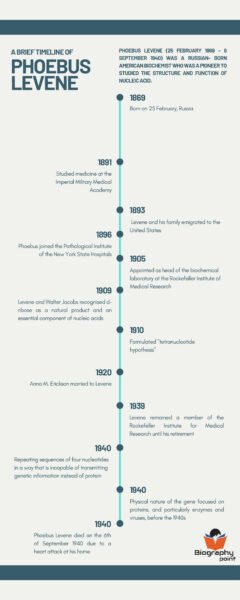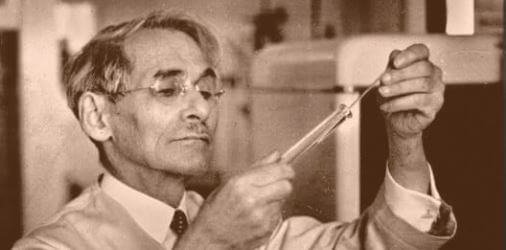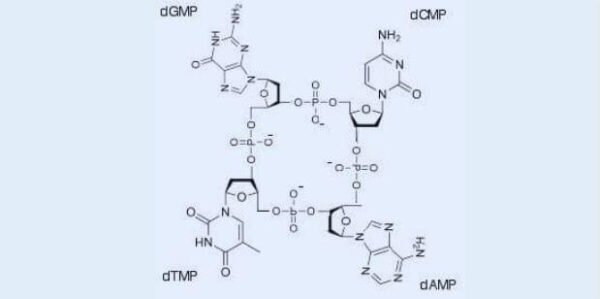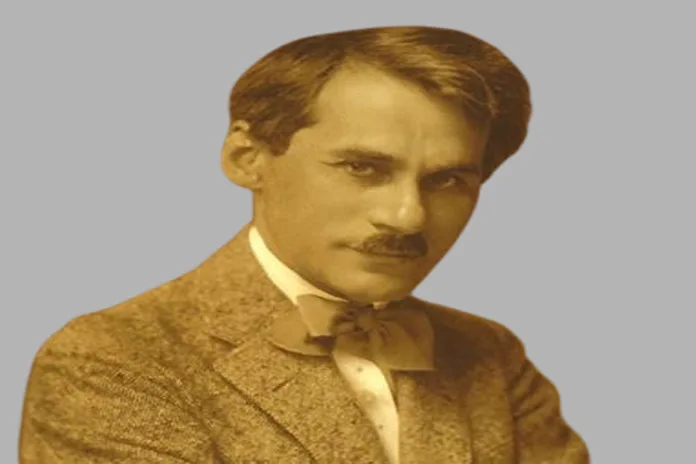Phoebus Levene (25 February 1869 – 6 September 1940) was a Russian- born American biochemist who was a pioneer to studied the structure and function of nucleic acid. Phoebus Levene’s full or original name was Fishel Aaronovich Levin and he was also called Phoebus Aaron Theodor Levene.
When Phoebus Levene worked with compounds, the most spectacular finding on that time was the isolation of sugars, 2-deoxyribose from the deoxyribonucleic acid (DNA) molecule and d-ribose from the ribonucleic acid (RNA) molecule that is considered the Levene most crucial contribution.
Phoebus Levene characterized the two different classes of nucleic acid, deoxyribonucleic acid (DNA) from ribonucleic acid (RNA), and also found that DNA contains phosphate group, deoxyribose, adenine, guanine, thymine and cytosine.
Early life and Education:
Phoebus Levene was born into a Lithuanian Jewish family in the town of Žagarė – a city located in northern Lithuania, Russia. Levene was the second of eight children born to Solom Michael Levene, a shirt maker, and the Etta (Brick) Levene. In 1873, when he was only two years old, his family migrated to St. Petersburg to enroll their children in private schools and the classical academy.
Phoebus was enrolled at the Imperial Military Medical Academy in St. Petersburg in 1886 where Borodin and his son–in–law Alexander Dianin taught chemistry. Levene was a brilliant student and due to that reason, his teachers were so impressed by Levene. They had given them the authority to allow him the laboratory freedom without any restrictions.

In this lab, he began research in organic chemistry on aldehyde and ketone condensation with phenols. At an early age, he inclined their interest in biochemistry. In 1891, Phoebus Levene’s family decided to migrate to America in search of broader prospects due to rising anti-Semitism in Russia. Levene’s family arrived in New York on the symbolic day of July 4, 1891. After he arrived in America, he practiced medicine on the Lower East Side in New York City.
Phoebus Levene was admitted as a special student at Columbia University, where he had given his time in research and medical practice in the department of physiology. In 1896, he joined the Pathological Institute of the New York State Hospitals as an associate in physiological chemistry. This time was hard for Levene because he contracted tuberculosis.
Saranac Lake was the place where he first interacted with Anna M. Erickson. Anna was born in Montana and married to Levene in 1920. Levene and Anna had no children. Phoebus Levene had a strong interest in modern art and literature, which was reflected in the design of their home. But even in a social situation, he kept his scientific pursuits at the forefront of all he did. His political beliefs were liberal; he favored the Kerensky administration, but he opposed the Bolsheviks.
The decision to leave medicine practice and dedicate his life to biochemical study when he was recovering from tuberculosis in Saranac Lake’s sanitarium. After that, he spent time at the Pathological Institute and Saranac Lake Laboratory to study tuberculosis, where he studied tuberculosis bacillus chemistry. While at Bern, Edmund Drechsel, Albrecht Kossel, and Emil Fischer were among the professors who taught him.
After studying nucleic acids at Marburg, he adapted Fischer’s novel ester fractionation process to explain gelatin amino acids in Berlin. In 1905, Simon Flexner founded the Rockefeller Institute for Medical Research who hired Levene to lead its biochemical investigations. He remained there until his retirement in 1939.
Phoebus Levene contribution to DNA:
Levene’s pioneering study on nucleic acids was particularly significant in his career. Although they were identified in 1871 and few knowledge was known about nucleic acid in 1900 other that they were found in nucleoproteins and had phosphoric acid groups connected with nitrogenous and non-nitrogenous substances. Levene demonstrated the occurrence of two distinct cell types.
One, readily produced from yeast, he demonstrated to be made of four nucleosides, one of which included the hitherto unknown sugar D–ribose. L–ribose, the optical isomer, had been synthesized lately in Europe and Levene demonstrated that his sugar was identical except for the direction of optical rotation. He also analyzed and synthesized hexose sugars, D–altrose and D–allose from D-ribose simple carbohydrate.
He later identified four nucleotides from the nucleic acid of yeast and found nitrogenous base, ribose and phosphoric acid in the DNA. Levene proved that nucleic acids are long-chain polymers made up of four monomeric nucleotides. As a result of his study, the nucleotide sequence, sugar ring structures, and the attachment positions of bases and phosphate units on sugars were all established in his lab.

As a proficient laboratory worker, Levene was an expert in utilizing scientific equipment with excellent efficiency. Animal studies were made much easier for him because of his background in medicine. Levene published over 700 scientific research papers that reveal his great interest and understanding in science. His scientific research demonstrates a thorough grasp of how to decipher the chemistry of biological processes.

During his early research, he was able to isolate certain kinds of proteins. Based on his analytical approach, Levene came to the conclusive point that the protein structure could be explained by classical valence theory based on his early work on the racemization of synthetic diketopiperazines. It took him a while to figure out how to use gelatin hydrolysate to get propylglycine anhydride, but he figured it out. It wasn’t long before his study on protein structure led to research on the non-protein components (lipoproteins, glycoproteins, and nucleoproteins) of conjugated proteins and thus nucleic acids, fatty acids, and sugars investigation.
Phoebus Levene Tetranucleotide Hypothesis:
According to the Levene tetranucleotide hypothesis, adenine (A), guanine (G), thymine (T) and cytosine (C) are the four nucleotides or bases are in equal composition that make up DNA the hereditary material. A commonly held belief prior to Erwin Chargaff’s discovery of the structure of DNA was that the repeating sequences of four nucleotides in a way that is incapable of transmitting genetic information instead of protein components of the chromosome.

Most genetic research before the 1940s relied on proteins, notably enzymes and viruses, as the foundation of heredity; this assumption was based on the chromosomes’ protein component. Levene’s hypothesis was rejected after the work of Erwin Chargaff.
Memberships and Awards:
Levene was an ingenious member of the National Academy of Sciences, the American Society of Biological Chemists, and several other American and foreign societies. He was nominated and earned the American Chemical Society’s Willard Gibbs Medal in 1931, and the New York section’s William H. Nichols Medal in 1938.
Phoebus Levene Death:
Phoebus Levene died on the 6th of September 1940 due to a heart attack at his home, 129 East Eighty-Second Street, New York, USA. At the time of his death, Levene age was seventy-one years old.

I love your blog.. very nice colors & theme. Did you create this website yourself? Plz reply back as I’m looking to create my own blog and would like to know wheere u got this from. thanks
Incredible! This blog looks just like my old one! It’s on a totally different topic but it has pretty much the same page layout and design. Excellent choice of colors!
Hey! Do you know if they make any plugins to protect against hackers? I’m kinda paranoid about losing everything I’ve worked hard on. Any tips?
Valuable information. Lucky me I found your web site by accident, and I’m shocked why this accident did not happened earlier! I bookmarked it.
Hey there! Do you know if they make any plugins to help with SEO?
I’m trying to get my blog to rank for some targeted keywords but I’m not
seeing very good gains. If you know of any please share.
Appreciate it!
Here is my site :: nordvpn coupons inspiresensation
I really like your blog.. very nice colors & theme.
Did you make this website yourself or did
you hire someone to do it for you? Plz answer back as I’m looking to create my own blog
and would like to know where u got this from. many thanks
Look at my webpage … nordvpn coupons inspiresensation (tinyurl.com)
Hi! I could have sworn I’ve been to this website before but after browsing
through some of the post I realized it’s new to me. Nonetheless, I’m
definitely happy I found it and I’ll be book-marking and checking back often!
Here is my web page nordvpn coupons inspiresensation (cfg.me)
Thanks for one’s marvelous posting! I definitely enjoyed
reading it, you’re a great author. I will remember to bookmark your blog
and will often come back at some point. I want to encourage you continue your great writing, have a nice afternoon!
Here is my web blog; nordvpn coupons inspiresensation
350fairfax nordvpn
Hmm it seems like your website ate my first comment (it was extremely long) so I guess
I’ll just sum it up what I had written and say, I’m thoroughly enjoying your blog.
I as well am an aspiring blog writer but I’m still new to everything.
Do you have any tips for inexperienced blog writers?
I’d genuinely appreciate it.
My web blog nord vpn promo
excellent post, very informative. I ponder why the opposite specialists of this sector do not understand this. You must proceed your writing. I am sure, you have a great readers’ base already!
wpzymspnxxozekknvtejderkevsypg
Hi there, just was aware of your weblog thru Google, and located that it’s really informative. I’m gonna watch out for brussels. I’ll be grateful for those who proceed this in future. Lots of other people might be benefited from your writing. Cheers!
hello there and thank you for your info – I have certainly picked up something new from right here. I did however expertise several technical issues using this site, as I experienced to reload the site lots of times previous to I could get it to load properly. I had been wondering if your hosting is OK? Not that I’m complaining, but slow loading instances times will often affect your placement in google and could damage your high-quality score if ads and marketing with Adwords. Well I’m adding this RSS to my email and can look out for much more of your respective interesting content. Ensure that you update this again soon..
Hey there this is kind of of off topic but I was wondering if blogs use WYSIWYG editors or if you have to
manually code with HTML. I’m starting a blog soon but have
no coding know-how so I wanted to get advice from someone with
experience. Any help would be greatly appreciated!
My homepage :: vpn
I think the admin of this website is genuinely working hard in support of his web
site, since here every stuff is quality based material.
I have read so many posts concerning the blogger lovers but this piece
of writing is in fact a nice post, keep it up.
I have been surfing online greater than three hours these days, but I never found any attention-grabbing article like yours. It’s lovely price enough for me. In my view, if all webmasters and bloggers made good content material as you probably did, the net will be much more useful than ever before.
Hey there! Someone in my Facebook group shared this website with us so I came to give it a look. I’m definitely loving the information. I’m book-marking and will be tweeting this to my followers! Wonderful blog and excellent style and design.
Some genuinely fantastic articles on this web site, appreciate it for contribution. “The spirit is the true self.” by Marcus Tullius Cicero.
I have recently started a website, the information you offer on this site has helped me greatly. Thanks for all of your time & work.
I conceive this internet site has got very good written subject material content.
I’m really enjoying the theme/design of your weblog. Do you ever run into any browser compatibility issues? A few of my blog visitors have complained about my site not working correctly in Explorer but looks great in Safari. Do you have any tips to help fix this problem?
I’m really enjoying the design and layout of your site. It’s a very easy on the eyes which makes it much more enjoyable for me to come here and visit more often. Did you hire out a developer to create your theme? Excellent work!
mgtguhqlmiywdrufzvnjwfqygvijqx
I’m typically to running a blog and i really admire your content. The article has actually peaks my interest. I’m going to bookmark your website and hold checking for brand new information.
Can I just say what a relief to find someone who actually knows what theyre talking about on the internet. You definitely know how to bring an issue to light and make it important. More people need to read this and understand this side of the story. I cant believe youre not more popular because you definitely have the gift.
zivsuqelnqohsrelhkjmegxmizjzft